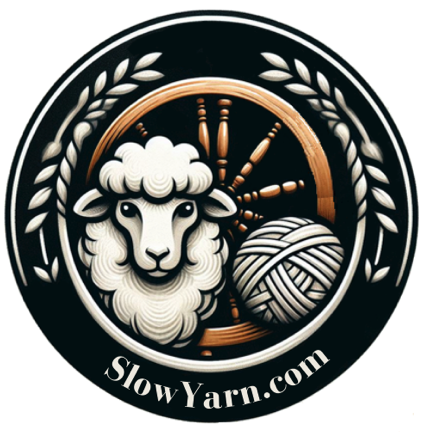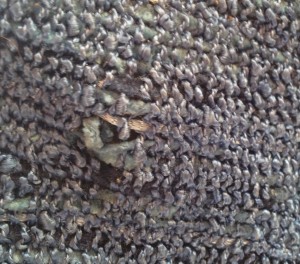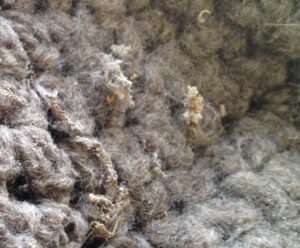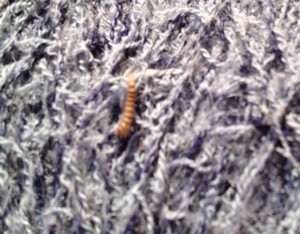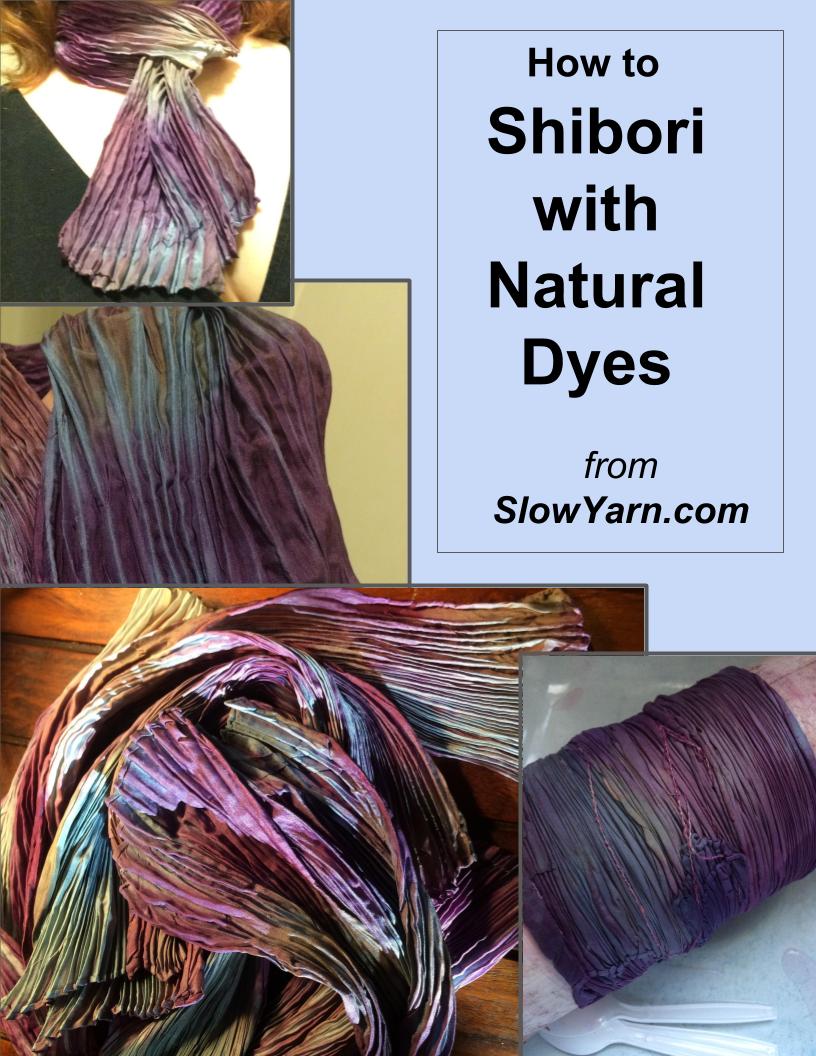Here’s how I learned the hard way about the tiny Wool Moth, Scourge of the Devil:
I had been hand spinning for a few months when I heard an offer for some free llama wool. Cool! It was fiber, and it was free. I took it, in a plastic grocery bag that wasn’t sealed in any way, set it in the middle of my stash of wool and other fibers, and forgot about it for awhile.
That was the single
most expensive free item
I ever received.
The next thing I knew, I had moths inside the house. I had moths inside my cedar chests! I had moths everywhere!
Over the next 30 years or so, I struggled to control the wool moths that were introduced into my stash through that “free” llama fleece. I had wool fleeces I’d bought at the Estes Park Wool Market. I had fancy rovings that were gifts from family. I bought tiny packages of exotic fibers to try spinning. I had started raising angora rabbits and had containers of the lovely soft angora fiber all over my house. And that’s only the handspinning fiber! All the wool sweaters from the grandmothers, wool hangings, wool rugs, hats, mittens, coats… we had a lot of wool.
Over that first year, the wool moth damage began.
I would occasionally open the lid to a box, or a cedar chest (yes, cedar chest!!!), and find bags that contained not luscious fiber, but dust. I threw them out, more puzzled than alarmed. I’m not talking about a few chewed damage spots with moth egg dust or casings. I mean entire gallon-sized Ziploc bags of angora turned to dust!!! My family and I did not recognize what was happening. We’d seen tiny moths around the house, but not swarms of them or anything obvious like that. And friends and relatives told us,
“There are no clothes moths in Colorado!” It’s too high, or dry, or something.
So we figured the moths we saw were meal moths that had come in with some of the bulk grains I got at the health food store. Chalk it up as one of the drawbacks of buying organic food, right?
I began to put together the puzzle pieces when I started finding holes in wool garments. Then I spotted a few strange “casings” stuck to some of my clothes. Occasionally, when vacuuming near my spinning wheels or wool stash, I would see these creepy little larvae husks that looked a lot like mealworms I’d seen in cornmeal a couple of times. Tiny black beetles were in a couple of my fleeces, and there was obvious damage to the fibers around them.
I had been invaded.
Every type of wool eating creature seemed to have invaded my house, and I could trace it all back to that free llama fleece.
The war began.
Let’s get a few things straight about moth control, because there are no simple solutions.
- I did not get wool moths because I didn’t clean my clothes.
- I could not just “put up one of those trap thingies” to make them disappear. More about that here.
- Cedar chests provided only the mildest of discouragement to these creatures. Cedar doesn’t kill them, prevent them, or keep my wool items stored inside all safe and bug-free if there were bugs in the wool before it went into the chest.
- Lavender, cedar, mint, pennyroyal, tea tree, citronella, eucalyptus—sachets of any of these helps to hide the sulfur scent of protein fibers to inhibit the little demons from being attracted to wool. These herbal sachets do NOT kill the moths, larvae, or eggs.
- Direct contact with pure tea tree oil would probably kill them—but it’s hard to soak an 11-pound sheep fleece in pure oils that come from tiny vials.
- Freezing does NOT kill wool moth eggs. In fact, it may increase gestation success.
- Putting the wool in the barn, with the extremes of Colorado weather, did not kill them.
- “Just get rid of all the infected wool” was not a practical solution once the infestation had taken hold. If I’d recognized it immediately, that could have worked.
- Grandma-knit sweaters which were some of the victims, and throwing them out seemed wrong, wrong, wrong.
- Spraying poison all over my house was not an option for me, with children and pets and allergies and morals.
- Spraying poison all over my house would not kill the eggs anyway.
- Spraying poison all over my house was unlikely to reach inside the dark containers that these creatures love.
- Poison doesn’t enter plastic baggies full of angora rabbit wool and permeate the fibers and seek out the larvae. It stays on the surface of the baggie, which I touch later.
So, what DID I do?
Looking back, I probably should have just tossed everything woolen into a bonfire and given up on it. Or opened up every bag of wool so air could get in, put it all in a room, shut the door, and bug-bombed it. Keep the cats and kids out of that room for awhile. (How long is long enough? The chemicals have half lives and might not be poisonous forever, but the carriers that deliver the chemicals are often toxic, and now they’re in the wool I’m going to spin into yarn for my kids’ garments, or sell to other people.) One of the bragging points about my wool was that it was raised naturally. I was not certified as an organic flock, but followed almost organic husbandry. Coating my fleece with chemicals was something to avoid.
What I did do:
- Tossed the obvious infestatons
- Vacuumed the corners and cracks wherever I could
- Put diatomaceous earth powder in crevasses and cracks, corners, and carpets.
- I washed all the wool garments as vigorously as I could without felting them, then put them inside the cedar chests.
- I opened those twice a year to shake out the garments and make sure they hadn’t started a breeding ground inside the dark chest.
- I made quarantine areas for fiber I thought could possibly be infested but I’d not seen evidence yet.
- Any new fiber entering the house or coming off the rabbits was put into thick, sealable plastic bags, double bagged, with lavender or cedar packets inside, and put into a safe chest or plastic bin that could be sealed.
- The best storage containers for wool are ones which let light in. Wool moths like the dark.
This infestation destroyed many thousands of dollars of wool over the years. At one point, I had a flock of rabbits, sheep, and angora goats, and each fleece had to be protected with the double bagging system. I could not in good conscience sell any wool products unless they were sent away straight off the sheared animal, or I was certain that they had been protected throughout the entire time they were at my house or barn.
I moved last year. I tossed any fiber that even might be infested. So far, I seem to have escaped the infestation, as the wool I have shows no evidence of damage. I continue to follow all my safety procedures, and won’t sell any wool I am not 100% certain is moth free.
But I know… all it takes is one free fleece.
To read more about my process for eliminating wool moths, click here.
Copyright © 2014 – 2023 Kelley Adams. All rights reserved.
All text, photos, and graphics are the property of Kelley Adams unless credit is given to an alternative source.
